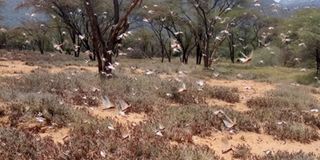Premium
Panic as desert locusts in northern Kenya start maturing

Desert locusts in Legarde, Samburu East on August 19, 2020.
What you need to know:
- The locusts are heavily feeding on vegetation and threatening food security for livestock.
- UN agency Fao said one swarm from the region last week crossed into northeast Uganda.
- Samburu has been reporting an average number of between five to eight swarms daily.
The government’s war to contain desert locusts in northern Kenya could take longer as some of the adult swarms in Samburu and Turkana counties have started maturing, presenting a likelihood of a generation of breeding once the October rains start.
Control operations have been intensified in the two counties as the government seeks to eliminate the destructive pests, which are heavily feeding on vegetation and threatening food security for livestock before they start breeding.
In a recent forecast, Food and Agriculture Organisation (Fao) said there is a possibility of a generation of locusts when the short rains start, offering a good environment for breeding.
The UN agency said one swarm from the region last week crossed into northeast Uganda and reportedly spread to Amudati, Moroto and Napak.
“There are several immature swarms prevailing in northwest Kenya and some of the adults have started to mature,” the UN agency said in the August 24 report.
Conflicts fear
Residents in the two counties that predominantly rely on pastoralism have already raised concerns that the insects could exhaust the remaining grasslands and prompt emaciation of their livestock and trigger resource-based conflicts.
The October rains could hamper the ongoing control operations and make some of the pests stay on due to cool temperatures and local winds in the affected counties.
Increased infestations also continues to worry officials as they could migrate to other counties after depleting vegetation in the two regions.
Samburu has been reporting an average number of between five to eight swarms daily which have covered about 180 hectares according to county Special Programmes Chief Officer Daniel Leisagor.
“We are trying our best to eliminate the immature, highly mobile and heavily feeding desert locusts before they completely devour grasslands and pose a huge threat to livestock food security,” the official said.
The focus, he said, is on decimating the pests as they could, after depleting the vegetation, migrate to neighbouring counties and countries in search of food.
Spraying
Samburu has since the first invasion in December last year reported 534 desert locust swarms out of which 334 were decimated through ground and aerial spraying while 200 other swarms either died naturally or migrated to neighbouring counties.
The Nation is aware that the team fighting the locust is hoping to eliminate the swarms before they mature and bring forth a third generation which could be disastrous and pose a huge threat to livestock existence.
The government had earlier announced that the invasion could be contained by the end of this month.
Agriculture PS Hamadi Boga said the government had put in place requisite measures to contain the invasion before the October rains through adequate training of the ground team, purchase of enough pesticides and sprayers.
Challenges
He admitted that the ground team continues to face challenges in tracking the destructive pests especially in remote areas that are inaccessible.
“We have trained all the staff in the frontline fight against the locusts, procured enough pesticides and equipment and are hopeful that the invasion will be contained by end of September,” Prof Boga told the Nation.
Agriculture CS Peter Munya said the swarms in Ethiopia, Somalia and Uganda are expected to be blown by wind towards Kenya next February and that the country is well prepared to contain the menace.
The CS said State agencies have made significant progress in eliminating the locusts, noting that all efforts had been concentrated in the two counties.




